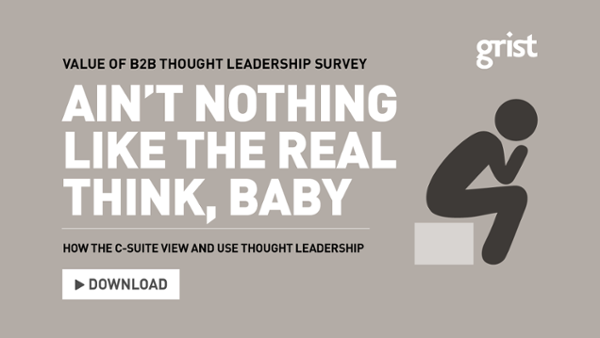High-quality thought leadership can cement an organisation’s reputation as a trusted partner. It can underscore perceptions of expertise. It can even help to close the deal. However, in an increasingly crowded market, thought leadership must hit the mark or risk being overlooked completely.
In 2016 we surveyed the C-suite of FTSE 350 firms to help our clients understand how the C-suite were consuming thought leadership.
We looked at what the C-suite expected from thought leadership, how and when it was consumed, and what would make it better. Our clients were subsequently able to tailor their content to be more effective.
In the intervening years, though, the way the world consumes information has changed. This is the post-Brexit, Trumpian era; the time when ‘fake news’ and social media scandals have taken their toll.
This latest survey, which this time was expanded to include senior executives at enterprise-level companies in the US, Europe and Asia, found a world much more comfortable with the idea of thought leadership – but much more demanding in what they want and need from it.
In this blog we share the dos and don’ts we can take from this year’s survey results:
Do this: Be useful
Our survey found 68% of senior executives read thought leadership to give them an edge over competitors, while 66% say it keeps them informed of emerging trends. The third most popular answer was enabling them to make better decisions (64%).
All three of these responses encapsulate the fundamental objective of all successful content marketing – to be of use.
Don’t do this: Promote the adviser rather than take a client-centric approach
It’s tempting to think that the era of self-serving, navel-gazing content marketing is over. It’s not. 42% of respondents cited self-serving content as their biggest turn off.
The content marketing mantra ‘be useful’ has never been more applicable. And the results are paradoxical – the more you talk about your firm, the more you alienate a target audience. Explicit expressions of your capabilities are less effective than implicit signals of competence and expertise demonstrated through useful, relevant, forward-thinking content.
No, it’s not about you. It’s about your clients.
Do this: Use data
Fresh thinking is at the core of thought leadership. However, our survey suggests that’s no longer enough. Robust data (44%) is now seen as the most important attribute – up from 29% in 2016 – and is vital when backing up fresh and opinionated thinking when it comes to thought leadership.
But why the sudden importance of data? The answer is simple. While the landscape is vast, it’s becoming increasingly crowded. The world is now littered with content masquerading as thought leadership, making ‘cut-through’ difficult.
Robust data with sound and informed analysis is what the C-suite is looking for. Adhere to this principle, and you’ll stand out from the crowd.
When it comes to what kind of research senior executives want, qualitative or quantitative, the answer is... both!
According to our survey, respondents slightly lean towards qualitative (39%) over quantitative (34%). And more than a quarter (27%) wanted both. It’s up to us, as marketers, to work out how best to provide this.
Don’t do this: Use unsubstantiated opinions
It may be a favourite mantra of Donald Trump, but ‘fake news’ has had a serious impact on thought leadership. That sense of mistrust and anxiety around the information we consume has crept into our business lives.
58% of our respondents cited unsubstantiated opinions as the biggest turn-off when it comes to thought leadership. Home in specifically on the US, and that figure rises to 66%, another example of the Trump-effect perhaps.
Brexit, along with Trump has also played its part in feelings of mistrust. Prior to the EU referendum in 2016, unsubstantiated opinions was fifth in the list of turn-offs. It’s now top. It’s another reminder that people are demanding that opinions are backed up with data.
Do this: Let the client see the clients
A common misconception about thought leadership is that the views the C-suite most wants to hear are those of other senior executives. In fact, the views most valued, are those of their customers. This was echoed in both this and our previous survey in 2016.
Don’t do this: Think they wouldn’t want to hear from you
Yet it’s not just the customers’ views they want to hear. Competitors or peers came in second with 48%, while industry experts (44%) and inspirational individuals outside the industry (41%) also featured high.
All this suggests the C-suite is interested in hearing from people outside of their immediate circle – those people that their company exists to help, and those who can provide outside perspectives.
However, perhaps most interestingly, over a third (34%) of the C-suite we talked to, wants to hear from advisory firms that specialise in the issue. These are the very firms that want to reach the C-suite with their thought leadership. It’s a relationship that’s built to succeed.
Do this: Include both long and short-form content in your comms strategy
When it comes to what formats senior executives prefer, blog posts came out on top (56%), closely followed by print magazines (53%). White papers and research reports (45%), infographics (44%) and video (44%) made up the top five formats, with the next highest, microsites, only being cited by 33% of respondents.
This suggests that in order to reach them, there is a need for an integrated communications strategy. This includes both short- and long-form content with PR and events such as roundtables enabling a greater reach for the thought leadership programmes.
Don’t do this: Have ‘shiny object’ syndrome
New digital channels are getting all the hype in marketing circles but perhaps they’re not right for your audience. Less than 30% of respondents said they favoured podcasts, apps, webinars or e-books. Now this may change over time, but don’t force the issue simply because you feel you should.
Do this: Meet your audience where they are
Asked to identify from where they are most likely to seek out thought leadership material, according to our survey, senior executives turn to professional networks (eg colleagues or peers) as the go-to source when seeking out thought leadership, with 57% of respondents citing it as number one.
Don’t do this: Have a build it and they will come mentality
The 'build it and they will come' mentality won’t work with content. Especially in an over-saturated environment. To be successful, you must target your content to the right audience, at the right place, at the right time, in order to drive business results.
According to our survey, recommendations from staff are most likely to prompt engagement with thought leadership, with 50% of respondents citing it as number one. However, 45% said they are prompted by email, 41% from peer recommendations, 32% by online discussions, 31% by online searching or browsing and 28% by social media.
This data suggests that, as marketers, you can’t sit back and wait for your audience to come to you, and when it comes to distribution, there is no silver bullet. Your campaign must work hard and cover all of the bases.
Do this: Love Mondays
When we asked our senior executives what day of the week and at what time they seek out thought leadership, we found some interesting results.
Monday (55%) proved to be the most popular day, by some distance. Wednesday was the second favoured day with 47%, but other than Monday, the difference in weekdays is negligible.
Less surprising was Saturday (19%) and Sunday (12%) being the days of the week that thought leadership was least likely to be consumed. Yet the fact that nearly one in five respondents are prepared to engage with thought leadership at the weekend points to the ease of access to information via smart devices. Another example of how the landscape is changing.
If Monday is the most popular day, the first part of the day is the most popular time, with 37% saying they were most likely to view thought leadership between 9am-12pm and 29% between 12-2pm, compared to 14% between 2-6pm.
Don’t do this: Do nothing
Noticeably, 41% of the C-suite we surveyed said they seek out thought leadership from professional services/advisory firms. But this opportunity is clearly also a risk – since if you are not creating the thought leadership they seek, and your competitors are, the senior executives may well end up on their sites rather than yours!
For more insights, download the full report:



